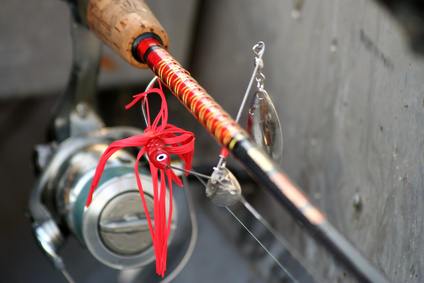
Understanding spinnerbait blades
Some great information of spinnerbait blades here:
“I think it is important to understand the mechanics of a spinnerbait,” explained Davis. “The bigger the blade you put on a lure the more lift it is going to have.” If you want to fish deeper obviously you want to use a heavier bait. Then reduce the blade size.
The natural tendency of spinnerbait fishermen is to start out with a bait right out of the package. Davis is quick to point out that you can change blades to come up with a combination that is going to work well for you.
Blades come in three basic shapes: Indiana, Colorado and willow leaf. The Indiana blade is a basic tear drop shape. The Colorado is similar but wider causing more vibration in the water. The willow leaf is more elongated and rotates faster in the water.
There are several reasons to change blades. You might want it to run shallow or make it run deeper. It should be matched to the size of the bait fish the bass are feeding upon. If there are a lot of small shad or small bait fish obviously you might want to go the same size blade or even a smaller bait.
On the other hand if you are seeing a lot of big forage fish you may want to go up in size. Davis recommends learning to fish the spinner bait shallow first. 1/4. 3/8 and ½ ounce baits are a good place to start. The only time to go with big spinner baits, the half or 3/4-ounce, out in deep water.
For deep water, Mark recommends a heavy bait. Cast it out to structure fishing such as drops. Crawl it slow across the bottom just like you would a crankbait or a jig. You actually fish it slow on the bottom.
A slow steady retrieve keeps those blades turning. It does the same thing that you are trying to accomplish with a crankbait. You can bump some cover down there, it can be a stump or some grass or a rock or some type of wooden structure. The idea is to get a reaction type strike out of that bass.
In clear water you want to keep your spinner bait near the surface. Unless you are slow rolling it deep. If you are fishing shallow clear water you want to keep that spinnerbait near the surface.
In stained water, the wind breaks the surface up. The fish do not see as well. That is why you want to keep that lure up close to that chop on top. Davis says he explain why, it just works. The key is to keep the lure up there shallow.
Most of the time we fish stained water. It is a textbook situation. There is something about stained water that causes bass to become object oriented. That puts fish close to objects. It could be cover, treetops and logs, brush. Those different pieces of cover are the objects that fish are using. That is why in stained water it is a good idea to throw a spinnerbait near an object. Source
Spinnerbait blades come in many sizes, shapes and colors. Whether you are fishing for smallies in rivers or lakes, they will produce, at certain times. If you are river fishing, try slow rolling the bait on the bottom in stained water, its loads of fun. Understanding the difference in the blades may not matter when the fish are red hot but when the bass are not quite as aggressive, it can make a difference.


